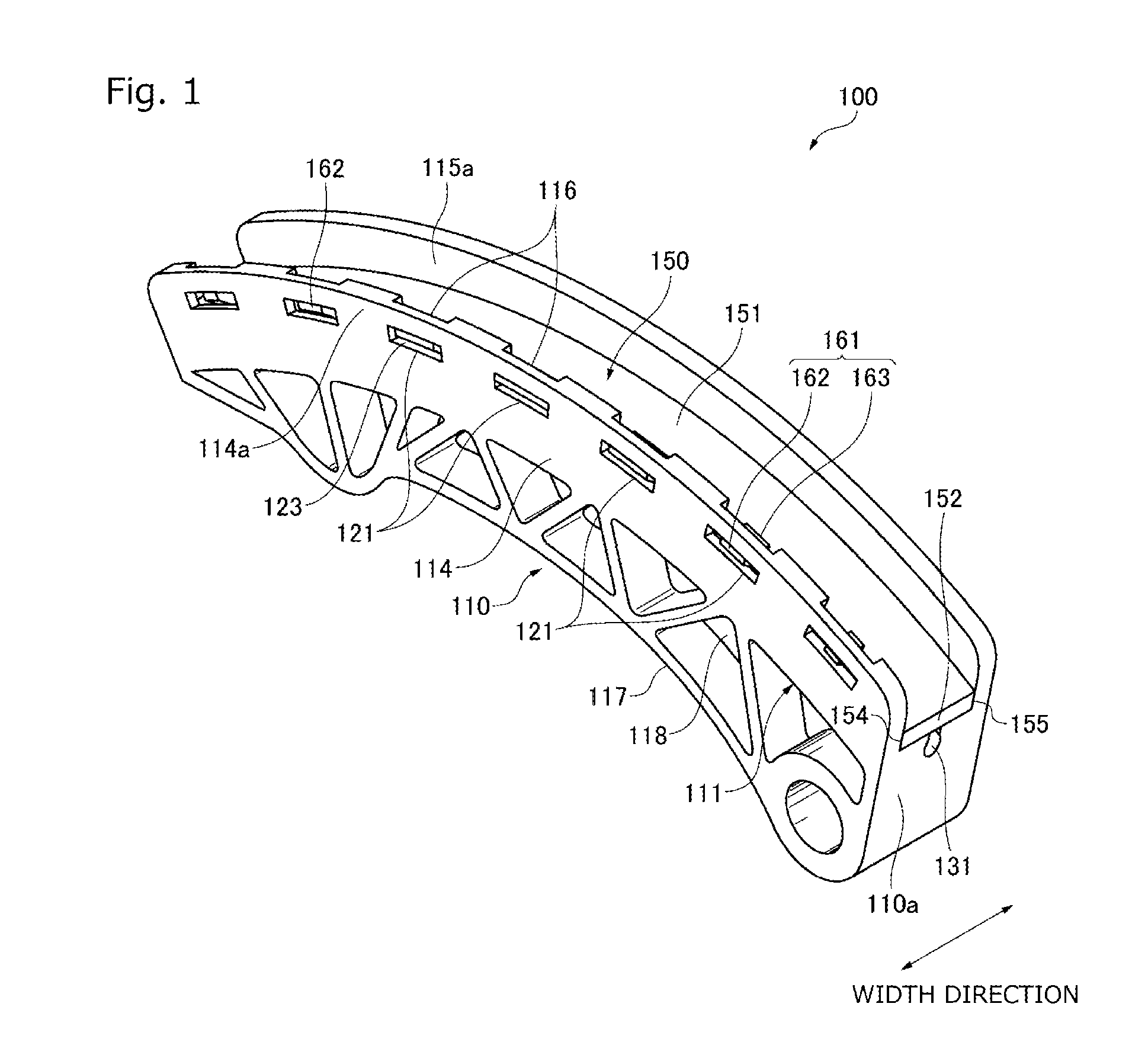Guide for flexible transmission member
a technology of flexible transmission and guide, which is applied in the direction of belt/chain/gearing, mechanical equipment, belts, etc., can solve the problems of poor guide assembling efficiency, increased cost, and largely manual assembling, so as to prevent shoe elevation prevent shoe looseness, and increase the mating force
- Summary
- Abstract
- Description
- Claims
- Application Information
AI Technical Summary
Benefits of technology
Problems solved by technology
Method used
Image
Examples
embodiment 1
[0053]FIG. 1 to FIG. 7 are diagrams for explaining Embodiment 1 of the present invention.
[0054]Referring to FIG. 1 and FIG. 2, the chain guide 100 (hereinafter, “guide”), or the guide for a flexible transmission member for guiding a chain 20, or the flexible transmission member, along a running direction thereof, is used in a wrapping transmission system, more specifically a timing wrapping transmission system, used in an engine, or a machine, in Embodiment 1 of the present invention.
[0055]This transmission includes an endless chain 20, a sprocket assembly formed by a plurality of sprockets on which the chain 20 is passed over, the guide 100 that forms a guide system brought into sliding contact with the chain 20 as it runs when driven by a drive sprocket included in the sprocket assembly, and a tensioner 21 that applies pressure on the guide 100. The guide 100 is a movable guide pivotally attached to an engine body, or a mounting part of the engine, to be pivotable around a pivot c...
embodiment 2
[0113]Referring to FIG. 10 to FIG. 12, in the chain guide 200 , the base-side lateral mating part Eb1 consists of one, or as in this case, a plurality of, lateral hole parts 221 as first base-side lateral mating elements, and one, or as in this case, a plurality of, lateral fit-in-joints 244 as second base-side lateral mating elements.
[0114]The shoe-side lateral mating part Es1 consists of lateral mating protrusions 261 as first shoe-side lateral mating elements, which are elastic mating elements, and lateral mating protrusions 281 as second shoe-side lateral mating elements, which are elastic mating elements.
[0115]The lateral fit-in-joints 244 are provided to both lips 214a and 215a, which are the protruded portions of the lateral rims 214, 215 of the base, respectively. Each fit-in-joint 244 includes a lateral recess 245 formed on the outer side in the width direction of the lip 214a or 215a as a lateral receiving part that forms a recessed space 247, or a lateral receiving space,...
embodiment 3
[0125]Referring to FIG. 13 to FIG. 15, the guide 300 has one, or as in this case a plurality of, notches 341 recessed downwards in both lips 314a and 315a. Each notch 341 is formed by a pair of stepped portions 342 provided in the height direction and spaced apart from each other in the longitudinal direction, and a bottom part 343 continuous with the stepped portions 342 and extending in the longitudinal direction. The bottom part 343 forms a lateral fit-in-joint 344 as the base-side lateral mating element that forms the base-side lateral mating part Eb1. The bridge 385 is located inside the notch 341.
[0126]The follower surface 382a of the tab 382 abuts on the distal end 348, which is an upper end portion of the bottom part 343, to cause an inward elastic deformation or deflection in the inner support part 384 as the shoe 350 moves downward toward the base 310 to allow the tab 382 to fit in the recess 345.
[0127]The first and second lateral mating elements e11 and e12 are arranged ...
PUM
 Login to View More
Login to View More Abstract
Description
Claims
Application Information
 Login to View More
Login to View More - R&D
- Intellectual Property
- Life Sciences
- Materials
- Tech Scout
- Unparalleled Data Quality
- Higher Quality Content
- 60% Fewer Hallucinations
Browse by: Latest US Patents, China's latest patents, Technical Efficacy Thesaurus, Application Domain, Technology Topic, Popular Technical Reports.
© 2025 PatSnap. All rights reserved.Legal|Privacy policy|Modern Slavery Act Transparency Statement|Sitemap|About US| Contact US: help@patsnap.com



